November 03, 2010
Alaska's Coastal Country Is Immense And It's Waterfowl Willing
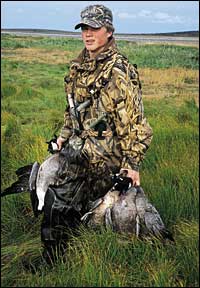 Levi slogs across the flats with his hands full. |
After some particularly tedious air travel from Milwaukee to King Salmon, Alaska, I was looking forward to simply arriving at our final destination, the small community of Pilot Point, out on the southwestern Alaska Peninsula. After cramming our gear into Rick Reynolds' dark blue 185, we were off on the final leg of our trip.
We had no sooner settled in to enjoy the ride when things got interesting. With Rick flying the Cessna purposefully low along the Bristol Bay coast, hunting partner Steve Loebaka spotted a big brown bear strolling down the beach. To give us a better look at our first Alaskan bruin, Rick hit a steep, descending turn that put us barely 50 feet above the bad boy's head as he defiantly stood up and pawed the air in a gesture that said, "C'mon, just try me!"
Advertisement
After a second photo pass, we continued on as Rick pointed out whale and walrus skeletons scattered along the beach. Turning inland then, we began to survey some of the endless ponds, marshes and lakes that pockmark this part of the Alaskan Peninsula we'd come to hunt.
With Pilot Point's distinctive shoreline looming in the distance we began to search for fowl in earnest. Rick's favorite areas showed good numbers of ducks and what we thought to be plenty of geese. However, Rick spoke in disappointing terms of the number of geese. "The cacklers aren't here in anything near the numbers they should, or will be. It being only the last week of September you're probably a little bit early, and given our unusually mild weather, the geese are running a tad late. But we should be okay."
Advertisement
Little did we know that his prophecy would so quickly come to bear.
With the unexpectedly spectacular flight under our belts we hastily stowed our gear in Rick's new lodge, changed into hunting clothes, grabbed a quick sandwich and headed out.
There were a total of six in our hunting party--Rick, Steve, myself, my son, Billy, Levi, a young guide from Minnesota who was serving as Rick's right hand man, and last, but certainly not least, Jud, Rick's half Lab, half Weimaraner dog.
It was a short jet boat ride from the launch site at Dago bay to the tidal flats the boys had chosen to hunt that first afternoon. As we hit the beach we could see a bunch of geese feeding on an eelgrass stand exposed by the low tide, no more than a half-mile off. Rick wanted to simply jump the birds, hoping, with the group spread out in the adjoining cover, to pass shoot them when and if they returned. It was then we learned that Levi, though young, was not shy about getting into the mix; he argued the merits of quickly deploying a decoy spread, to lure any returning bird, within range of all the guns.
I sided with Levi, and in short order was glad I did.
After setting the spread, a four-dozen decoy mixture of floaters, shells and silhouettes, we hunkered down in a thick stand of taller grass to wait. It took a good half-hour before the geese began to drift back our way. That first wave of 30 cacklers was really intrigued by the Judas geese, and when they swung low over my head on locked wings, two of the three shots connected. Judd had no sooner collected the pair than a second flock arrived. Once again my stars were aligned, as the birds worked right to me. Hanging at less than 30 yards I took an easy right and left, filling my four-bird limit.
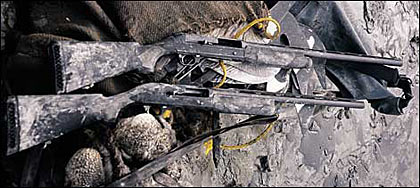 The tidal flats are tough on equipment. |
Just like un-hunted ducks flushed from a prairie pothole, the geese continued to return, drawn no doubt by the allure of the lush eelgrass stand; and all the boys got in on the action.
When things finally slowed down with the geese, Levi plopped a dozen and a half mallard blocks on a nearby pothole, and in short order we had a decent little duck shoot going. The ducks, mostly pintails with a smattering of mallards, gadwall and teal, worked classically, as un-pressured birds normally do.
With the high tide finally threatening to overtake our position, we had to call it a day. Rick, who'd slogged after the skiff, was able to drive it right across the then-submerged flat to pick us up. With high-fives all around, we finished the shoot with 17 geese, 16 ducks, and one tired dog.
It had been a great start to our first Alaskan experience.
This trip developed out of my lifelong dream of hunting and fishing in Alaska. At age 52, the reasons I hadn't done it to this point were several.
First off, Alaskan adventures, by their remote nature, require a high cost of travel. With such basic priorities as raising a family, putting kids through college, and planning financial futures, the Alaska deal always took a back burner. Then too, bird hunting, primarily waterfowling, had always been my first love, and more or less directed my shooting life. Because Alaskan hunting, in my mind anyway, had always been synonymous with big game, it took me awhile to realize that our largest state had some very unique and high-quality bird hunting to offer as well.
As for fishing: Given that I've been a Great Lakes salmon and trout angler since my teenage years, and that the upper-Midwest's and Canada's walleyes draw most of my angling attention, Alaskan fishing never ranked as high a priority as it probably should have.
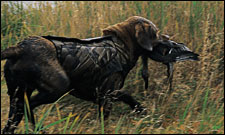 Rick Reynold's gun dog, Jud. |
All negatives aside, the Alaskan urge began to overwhelm me at the turn of the millennium, so I got serious with my research. When I finally connected with Rick Reynolds, a lifelong Alaskan, I could sense he was just as waterfowl-driven. After following up with his sidekick, Levi, I was sure of it. When Rick explained that the tidal flats in Pilot Point serve as a major Alaskan staging area for all the Cackler Canada's in the Pacific flyway each October; and when Levi expressed his desire to work the birds over decoys, my interest was piqued. When Rick all but guaranteed a slam-dunk on all the fishing we wanted, I was in. And it didn't take much convincing for Billy and Steve to sign on.
We return
ed to the Dago creek flats the second day of our hunt, roughly duplicating the results of our first outing. But by the end of the hunt it was evident we'd fully educated the birds in that area. The arctic-nesting cacklers were fast proving darn near as wild and wary as Central Flyway snows.
With a devilish gleam in his eye, Rick announced over a pintail dinner that evening, "Tomorrow we'll introduce you to the goose flats. Then we'll see if you're really up to this Alaskan waterfowling."
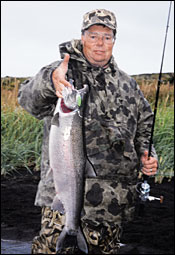 The author with a silver, for supper. |
To get to the area he referred to as "the flats," we needed to use Rick's 22-foot aluminum sea skiff. Though stationed high and dry on the beach since the summer's commercial fishing season, launching it should not have been much of problem. But with gusty 35-knot winds pounding six- to eight-foot breakers on the beach, getting the big tub in the water proved a drenching and dicey task. After launching the skiff and expertly handling it in the surf, it was obvious Rick's seamanship was at least on a par with his ability to fly a bush plane.
Once out on the flats, it was a matter of simply going with the program. Rick dropped us off one at a time, one half to one mile apart, with the express but simple instruction to "Walk at least one hour in from the beach. Then look for birds trading and try to move into position to pass shoot them."
Slogging in waders through ankle-grabbing sedges and grasses, some as high as your head, and having to struggle across tidal creeks with bottoms covered in slimy, greasy, boot-sucking mud, often as deep as your thigh, was for me and my arthritic back, like being on a death march. But it's one we made, simply because the further we struggled inland the more birds we found.
I, for one, held off shooting until I finally hooked up with Rick later in the afternoon. Though there were opportunities aplenty, especially at ducks, I knew my nose doesn't work well enough to find birds I drop into such thick cover. In the end, Billy, Steve and Levi's experiences had mirrored mine. We'd all taken only a handful of birds from those shooting opportunities that we knew would allow us to drop them onto the open mudflats or into shorter grass.
But, to a man, we could see the potential. Drop some floating blocks on a prominently used pond, or set some silhouettes out on a mud flat, and we might well be in business. One thing we learned for certain: This was no gentlemanly jaunt to a heated pit or blind. We were in for some hardcore, mud-from-head-to-toe, work-your-butt-off waterfowling.
The Cast Executing our newly formed plan would have to wait because our next day's agenda called for us to fly inland and hookup with Rick's good friend, and another Alaskan outfitter, Gary LaRose. It seemed Gary had some serious casting lined up to go along with our blasting.
It was a short flight to Gary's camp from which he and his Cessna 180 shuttled us in pairs to the Cinder River. Being a weekend-warrior pilot myself I was having fun talking flying (a basic Alaskan dialect I'd come to learn), when Gary abruptly pointed out the river below and his intended "landing strip" nearby.
With that excitement aside, Gary's man, Will Robert, soon ushered us 300 hundred yards through the bush to streamside. As we rigged our spinning gear, Will pointed to the salmon rolling just upstream. "The river's full of silvers and most of your hookups will come from the dark, red-colored males that will be aggressively defending the nests. But there's a fresh run of bright (silver-sided) salmon as well if you want to take a fish or two to eat.
Billy was first into the water, with Steve not far behind, and they both hooked up on their first casts. It took me until my fourth throw to get a bite, but it was a spectacular strike. I could see the fish coming, bulging the surface like a big Musky fully 20 feet, before it sucked in my gaudy Mepps spinner. It was quite a scene with all three of us hooked to 10- to 14-pound thrashing salmon. It wasn't as if we'd never fished before, but the experience, in such a beautiful and remote setting, was just so special it is hard to describe.
I don't know how many fish we hooked and/or landed that day. And it doesn't matter. All I do know is the fish darn near wore us out. We fished until we almost dropped!
When we heard the distant drone of Gary's bird on our pickup run I had mixed emotions. It was a day I didn't want to end yet one I knew, due to sheer fatigue, couldn't continue. But what a memory-maker it had been. Will, a lifelong Alaskan, summed it up for us: "As for silver fishing boys, it just doesn't get any better than this!"
Back at Rick's, we were served the best salmon dinner I'd ever eaten.
It was back to the flats the next day, but this time with a plan. Billy and Levi were going to set up a spread of floaters on a tidal pond while Steve and I deployed a set of silhouettes on a mud flat. Rick would stubbornly stick to his standard walk- and pass-shoot routine.
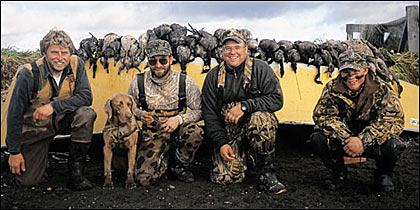 Alaskan tidal flat hunting--tough but productive. |
While we could hear the sporadic gunfire of our partners off in the distance, Steve and I enjoyed steady, sometimes spectacular action right from the get-go. Enough cacklers gave our spread a close look to allow us to reach our limits. And a variety of ducks, mostly pintails and mallards, worked us as singles, pairs and small flocks. We could easily have filled on ducks several times over.
At day's end, we compared bags. Billy and Levi's hunt had proven similar to ours. Coming out on the short end of the stick, Rick took grudging note of our success.
The next and final day of our trip proved a near carbon copy of the day before, with the notable exception of Rick and Jud joining Steve and I for some classic decoy shooting. As if to put an exclamation point on the hunt, everyone shot exceptionally well. Doubles were common and clean kills the rule.
We finished the day chasing ptarmigan on the outskirts of town. This was a tasty desert following the hearty meal that was the day's waterfowling.
And so our Alaskan sojourn had come to an end. But it was a trip that will be forever remembered as one that had it all.
There was the pure adventure of a first-ever trip to a remote and wild land. The scenery, complete with ocean vistas and snow-capped volcanic mountains, when not obscured by the ever-present low scud and sea mist, was spectacular. And the wildlife didn't disappo
int. Brown bears, moose, caribou, seals, beluga whales, the rare and protected emperor geese and of course the wildfowl, were found in abundance.
But as much as anything else, this trip will be remembered as a week in waders. Southwestern Alaska is a soggy land, and whether hunting or fishing, to deal with it you'd better be well booted.
In the end it had been a trip of a lifetime. To see, feel, touch, and maybe even become a little part of this wet and wild corner of our great land, was truly something special.

